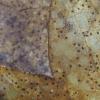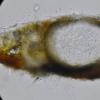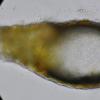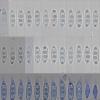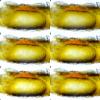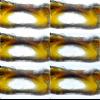
09-11-2025 13:20
Hello.A tiny ascomycete, appearing as erupting gra

08-11-2025 00:29
 Francois Guay
Francois Guay
I found this species in Quebec, Canada, on herbace

08-11-2025 09:15
 Michel Hairaud
Michel Hairaud
Bonjour,ô Pouvez vous m'aider û identifier ce Mol

04-11-2025 09:07
Hello.A suspected Hymenoscyphus sprouting on a thi

04-11-2025 12:43
 Edvin Johannesen
Edvin Johannesen
Hi! One more found on old Populus tremula log in O

03-11-2025 21:34
 Edvin Johannesen
Edvin Johannesen
These tiny (0.4-0.5 mm diam.), whitish, short-stip

Good afternoon
Do you know what this "Pyreno" could be? In Acer leaves, surely A. monspeliensis. They are soft black dots, bulging when hydrated, tiny, which occupy the entire width of the leaf, as you can see in the photos. It doesn't look like a classic Pyreno, it probably isn't.
The asci have a curious apical apparatus, very marked, but it is inamyloid. All asci I've seen have that irregular shape on the walls, I assume they're alive, although it looks like they're not. Spores are 2-celled, with 4 large LBs, 2 per cell, and hyaline conical appendages at the ends.
Orienting myself for the spores I have gone to the genera Anisomeridium, Naetrocymbe, Lophiostoma, Vaginatispora, Lophitrema, Pseudocoleophonea and Wettsteinina, but I don't see anything like that.
These are the measurements:
Spores
(15.5) 16.1 - 17.4 (18.3) û (4.1) 4.7 - 5.3 (5.6) ôçm
Q = (3) 3.1 - 3.6 (4) ; No. = 38
Me = 16.7 û 5 ôçm; Qe = 3.4
Asci
(60.1) 60.6 - 72 (83.9) û (10.8) 11.8 - 14.5 (15.6) ôçm
Q = (4.2) 4.4 - 5.7 (6) ; No. = 42
Me = 67.1 û 13.3 ôçm; Qe = 5.1
Thank you so much.
Miguel û. Ribes

A photo of the asci would be very helpful here.
Are the asci swimmig in the perithecial centre? I ask this because the asci seem to have a Diaporthe-like apical ring, spores are Diaporthe-like too. So we have perhaps to look for your collection in the Diaporthales/Sordariomycetes instead of the Dothideomycetes.
Regards,
Bernard
I think, as Bernard, says, you should look at the Diaporthales, the strongly refractive inamyloid apical apparatusô and the sharply cut asci indicate this.

The fifth photo shows asci in water, iki and in blue ink.
I think asci are free swimming in the perithecium. I will find in Diaporthales.
Thanks a lot

I will try to make sections now in dry-state. In fresh-state (fig. 2, 3) it is very soft and crushes.

Leaf-inhabiting genera of the Gnomoniaceae, Diaporthales.ô M.V. Sogonov, L.A. Castlebury, A.Y. Rossman, L.C. MejûÙa and J.F. White. 2008
A systematic account of the genus Plagiostoma (Gnomoniaceae, Diaporthales) based on morphology, host-associations, and a four-gene phylogeny.ô L.C. MejûÙa, L.A. Castlebury, A.Y. Rossman, M.V. Sogonov and J.F. White, Jr. 2011.
I don't find information about L. bavaricum.
Thank you.
In-depth studies should be carried out, as Sogonov, Meijia and Walker have been able to do in certain groups of these Gnomoniaceae.
The situation is similar for species on Euphorbia or Geranium: perhaps an updating needs to be made using molecular biology, by bringing in new species.
Alain

I see that it is another group in which it is necessary to deepen, including molecular studies. My samples are available to whoever is needed.
I still can't find documentation on Plagiostoma bavaricum beyond the original description of Hypospila bavarica, I would appreciate any documentation on the species.
Thank you.
Gnomoniaceae but it cannot be placed in a genus. As Alain says, more studies would be needed to try to better define this or these species.


ô I will find it again sometime.
Thanks Enrique
